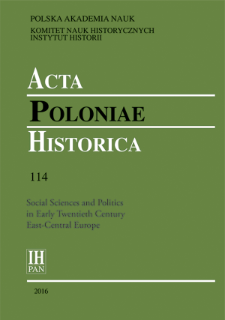- Wyszukaj w całym Repozytorium
- Piśmiennictwo i mapy
- Archeologia
- Baza Młynów
- Nauki przyrodnicze
Wyszukiwanie zaawansowane
Wyszukiwanie zaawansowane
Wyszukiwanie zaawansowane
Wyszukiwanie zaawansowane
Wyszukiwanie zaawansowane

Obiekt
Tytuł: Military aspects in the spatial development of Polish cities in the nineteenth century
Inny tytuł:
Acta Poloniae Historica T. 114 (2016) ; Studies
Współtwórca:
Hartzell, James : Red. ; Komitet Nauk Historycznych Polskiej Akademii Nauk ; Instytut Historii Polskiej Akademii Nauk
Wydawca:
Instytut Historii Polskiej Akademii Nauk
Miejsce wydania:
Opis:
Typ obiektu:
Abstrakt:
Military issues were deemed vital in the European politics of the nineteenth century. The aim of this article is to trace the most important implications of the ‘military bias’ of state authorities in the border region between the three empires (Germany, Russia and Austria – later the Austro-Hungarian Empire) which occupied the Central and Eastern part of the continent. Military authorities sometimes exercised a particularly strong influence upon urban policy. The two major issues addressed in this article are the fortifications (their creation, strengthening, and spatial development) which influenced urban sprawl – though perhaps not so much as is maintained in the scholarly literature – and the development of railways. The directions and tracks chosen for the railways were also influenced by the military plans, which in turn often differed much from the visions of the urban officials who made up the administration of the city.
Bibliografia:
Beyrau Dietrich, Militär und Gesellschaft im vorrevolutionären Russland (Köln, 1984).
Black Jeremy, War in the Nineteenth Century, 1800–1914 (Cambridge, 2009).
Bloch Jan, The Future of War in Its Technical, Economic, and Political Relations; Is War Now Impossible? (New York and Boston, 1899).
Bogdanowski Janusz, Warownie i zieleń twierdzy Kraków (Kraków, 1979).
Demel Juliusz, Początki kolei żelaznej w Krakowie (Kraków, 1954).
Głowiński Tomasz and Klementowski Robert (eds.), ‘Mkną po szynach...’ Z dziejów transportu i komunikacji na ziemiach polskich na przestrzeni wieków (Wrocław, 2014).
Grote Ludwig (ed.), Die deutsche Stadt im 19. Jahrhundert. Stadtplanung und Baugestaltung im industriellen Zeitalter (München, 1974).
Kleczke Karol and Wyszyński Władysław, Fortyfikacja stała (Warszawa, 1937).
Kołodziejczyk Ryszard (ed.), Studia z dziejów kolei żelaznych w Królestwie Polskim 1840–1914 (Warszawa, 1970).
Krajewski Mieczysław, Dzieje głównego dworca kolejowego w Warszawie (Warszawa, 1971).
Królikowski Lech, Twierdza Warszawa (Warszawa, 2002).
Mintzker Yair, The Defortifi cation of the German City, 1689–1866 (Cambridge et al., 2012).
Ostrowska-Kębłowska Zofia, Architektura i budownictwo w Poznaniu w latach 1780–1880 (Poznań, 2009).
Pietrzak-Pawłowska Irena (ed.), Wielkomiejski rozwój Warszawy do 1918 r. (Warszawa, 1973).
Purchla Jacek, Jak powstał nowoczesny Kraków (Kraków, 1990).
Studia i Materiały do Historii Wojskowości (1966, 1976, 2009).
Czasopismo/Seria/cykl:
Tom:
Strona pocz.:
Strona końc.:
Szczegółowy typ zasobu:
Format:
Identyfikator zasobu:
oai:rcin.org.pl:62663 ; 2450-8462 ; 10.12775/APH.2016.114.09
Źródło:
IH PAN, sygn. A.295/114 Podr. ; IH PAN, sygn. A.296/114 ; kliknij tutaj, żeby przejść
Język:
Prawa:
Licencja Creative Commons Uznanie autorstwa-Bez utworów zależnych 4.0
Zasady wykorzystania:
Zasób chroniony prawem autorskim. [CC BY-ND 4.0 Międzynarodowe] Korzystanie dozwolone zgodnie z licencją Creative Commons Uznanie autorstwa-Bez utworów zależnych 4.0, której pełne postanowienia dostępne są pod adresem: ; -
Digitalizacja:
Instytut Historii Polskiej Akademii Nauk
Lokalizacja oryginału:
Biblioteka Instytutu Historii PAN
Dofinansowane ze środków:
Program Operacyjny Innowacyjna Gospodarka, lata 2010-2014, Priorytet 2. Infrastruktura strefy B + R ; Unia Europejska. Europejski Fundusz Rozwoju Regionalnego
Dostęp:
Kolekcje, do których przypisany jest obiekt:
- Repozytorium Cyfrowe Instytutów Naukowych > Kolekcje Partnerów > Instytut Historii PAN > Czasopisma
- Repozytorium Cyfrowe Instytutów Naukowych > Kolekcje Partnerów > Instytut Historii PAN > Wydawnictwa Instytutu
- Repozytorium Cyfrowe Instytutów Naukowych > Kolekcje Partnerów > Instytut Historii PAN > Wydawnictwa Instytutu > Czasopisma
- Repozytorium Cyfrowe Instytutów Naukowych > Kolekcje Partnerów > Instytut Historii PAN > Wydawnictwa Instytutu > Czasopisma > Acta Poloniae Historica
- Repozytorium Cyfrowe Instytutów Naukowych > Piśmiennictwo > Czasopisma/Artykuły
Data ostatniej modyfikacji:
22 wrz 2023
Data dodania obiektu:
25 maj 2017
Liczba pobrań / odtworzeń:
668
Wszystkie dostępne wersje tego obiektu:
https://rcin.org.pl./publication/82034
Wyświetl opis w formacie RDF:
Wyświetl opis w formacie RDFa:
Wyświetl opis w formacie OAI-PMH:
| Nazwa wydania | Data |
|---|---|
| Łupienko, Aleksander (1980- ), Military aspects in the spatial development of Polish cities in the nineteenth century | 22 wrz 2023 |
Obiekty Podobne
Opaliński, Dariusz (1970– )
Pieczewski, Andrzej (1971– )
Łupienko, Aleksander (1980– )
Song, Yan Gil, Jorge Wandl, Alexander Timmeren, Arjan van
Bende, Csaba Nagy, Gyula
Getka-Kenig, Mikołaj (1987– )
Śleszyński, Przemysław
Wolny, Ada Źróbek, Ryszard

 INSTYTUT ARCHEOLOGII I ETNOLOGII POLSKIEJ AKADEMII NAUK
INSTYTUT ARCHEOLOGII I ETNOLOGII POLSKIEJ AKADEMII NAUK
 INSTYTUT BADAŃ LITERACKICH POLSKIEJ AKADEMII NAUK
INSTYTUT BADAŃ LITERACKICH POLSKIEJ AKADEMII NAUK
 INSTYTUT BADAWCZY LEŚNICTWA
INSTYTUT BADAWCZY LEŚNICTWA
 INSTYTUT BIOLOGII DOŚWIADCZALNEJ IM. MARCELEGO NENCKIEGO POLSKIEJ AKADEMII NAUK
INSTYTUT BIOLOGII DOŚWIADCZALNEJ IM. MARCELEGO NENCKIEGO POLSKIEJ AKADEMII NAUK
 INSTYTUT BIOLOGII SSAKÓW POLSKIEJ AKADEMII NAUK
INSTYTUT BIOLOGII SSAKÓW POLSKIEJ AKADEMII NAUK
 INSTYTUT CHEMII FIZYCZNEJ PAN
INSTYTUT CHEMII FIZYCZNEJ PAN
 INSTYTUT CHEMII ORGANICZNEJ PAN
INSTYTUT CHEMII ORGANICZNEJ PAN
 INSTYTUT FILOZOFII I SOCJOLOGII PAN
INSTYTUT FILOZOFII I SOCJOLOGII PAN
 INSTYTUT GEOGRAFII I PRZESTRZENNEGO ZAGOSPODAROWANIA PAN
INSTYTUT GEOGRAFII I PRZESTRZENNEGO ZAGOSPODAROWANIA PAN
 INSTYTUT HISTORII im. TADEUSZA MANTEUFFLA POLSKIEJ AKADEMII NAUK
INSTYTUT HISTORII im. TADEUSZA MANTEUFFLA POLSKIEJ AKADEMII NAUK
 INSTYTUT JĘZYKA POLSKIEGO POLSKIEJ AKADEMII NAUK
INSTYTUT JĘZYKA POLSKIEGO POLSKIEJ AKADEMII NAUK
 INSTYTUT MATEMATYCZNY PAN
INSTYTUT MATEMATYCZNY PAN
 INSTYTUT MEDYCYNY DOŚWIADCZALNEJ I KLINICZNEJ IM.MIROSŁAWA MOSSAKOWSKIEGO POLSKIEJ AKADEMII NAUK
INSTYTUT MEDYCYNY DOŚWIADCZALNEJ I KLINICZNEJ IM.MIROSŁAWA MOSSAKOWSKIEGO POLSKIEJ AKADEMII NAUK
 INSTYTUT PODSTAWOWYCH PROBLEMÓW TECHNIKI PAN
INSTYTUT PODSTAWOWYCH PROBLEMÓW TECHNIKI PAN
 INSTYTUT SLAWISTYKI PAN
INSTYTUT SLAWISTYKI PAN
 SIEĆ BADAWCZA ŁUKASIEWICZ - INSTYTUT TECHNOLOGII MATERIAŁÓW ELEKTRONICZNYCH
SIEĆ BADAWCZA ŁUKASIEWICZ - INSTYTUT TECHNOLOGII MATERIAŁÓW ELEKTRONICZNYCH
 MUZEUM I INSTYTUT ZOOLOGII POLSKIEJ AKADEMII NAUK
MUZEUM I INSTYTUT ZOOLOGII POLSKIEJ AKADEMII NAUK
 INSTYTUT BADAŃ SYSTEMOWYCH PAN
INSTYTUT BADAŃ SYSTEMOWYCH PAN
 INSTYTUT BOTANIKI IM. WŁADYSŁAWA SZAFERA POLSKIEJ AKADEMII NAUK
INSTYTUT BOTANIKI IM. WŁADYSŁAWA SZAFERA POLSKIEJ AKADEMII NAUK


































